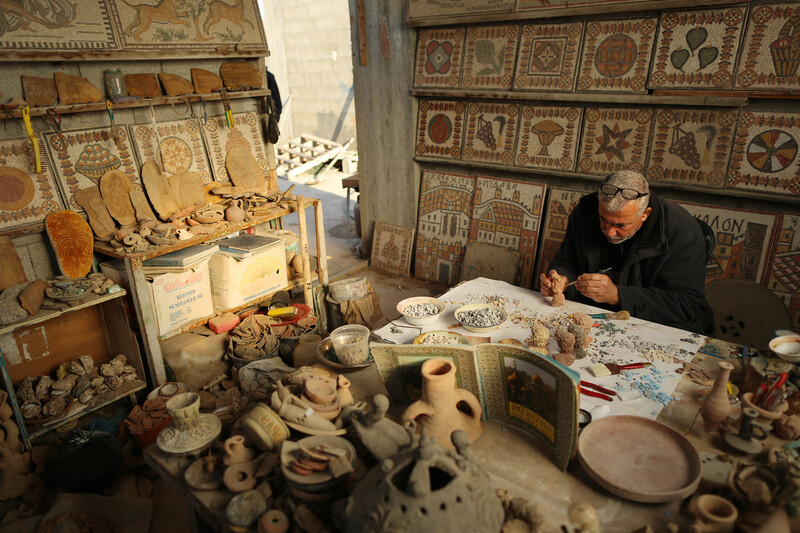A flotilla bound for Gaza carrying food, medicine and other humanitarian aid was intercepted and seized by the Israeli Navy on October 5. The Women’s Boat to Gaza had set sail from the Spanish port city of Barcelona in mid-September in an effort to break the ongoing Israeli blockade of Gaza, Democracy Now! said on October 12.
Gaza siege
 Nafez Abed at his Gaza rooftop workspace. Photo: Momen Faiz/Electronic Intifada.
A small room on a rooftop in the occupied Gaza Strip’s crowded Beach refugee camp resembles a miniature archaeological museum.
It is the workshop of Nafez Abed, 55, who studies archaeological artefacts in order to replicate them in exquisite detail.
Nafez Abed at his Gaza rooftop workspace. Photo: Momen Faiz/Electronic Intifada.
A small room on a rooftop in the occupied Gaza Strip’s crowded Beach refugee camp resembles a miniature archaeological museum.
It is the workshop of Nafez Abed, 55, who studies archaeological artefacts in order to replicate them in exquisite detail.
Two new global developments emphasised the growing momentum of the global boycott, divestment and sanctions campaign targetting Israel.
The campaign was launched in 2005 by more than 100 Palestinian civil society groups in a bid to isolate Israel over its polices of occupation and apartheid against Palestinians.
The ongoing siege of Gaza by the Israeli government looked set for a worrying escalation following a visit to Gaza by the emir of Qatar. Just three days earlier, Israel's navy had boarded a Gaza aid ship and used tasers on activists. Sheikh Hamad bin Khalifa al-Thani entered Gaza via Egypt's Rafah border crossing on October 23. Israeli leaders condemned al-Thani's visit, the first by a foreign head of state since 1999. Al-Thani promised $400 million in aid projects to Gaza, undermining Israel's economic blockade.
On May 31, Australian activists Ahmed Talib and Jerry Campbell were on board the Mavi Marmara, in international waters, en route to Gaza to deliver much needed aid to its besieged residents. Israeli commandos attacked the ship and shot dead nine solidarity activists. Talib was one of several activists shot and wounded. He and Campbell described the attack at a September 22 forum sponsored by Justice For Palestine.
Talib said: “The Israeli siege of Gaza had continued for three years, with world governments and international organisations not really doing anything against it.”
The article is abridged from an August 11 Palestinian Centre for Human Rights report.
* * *
The signs which dot the beach along the Gaza City waterfront read: "This beach is polluted.” Yet they serve only as obstacles for children running to the sea, rather than warnings of the serious health risks.
One need only stroll north along the beach for a couple hundred metres to see raw sewage being pumped directly into the Mediterranean Sea from one of the 16 discharge sites along the coast.
Yet thousands of people fill Gaza's beaches.
Al-Sharq al-Awsat said on July 15 the Libyan aid ship, Amaltheal (“Hope”) docked the night before at al-Arish in Egypt. The ship was bearing 2000 tons of aid supplies for the Palestinians in the Gaza Strip, which is blockaded by Israel.
The ship’s odyssey from Greece was marked by uncertainty and danger for the 21 passengers. It developed a mechanical problem that made it move very slowly on July 14. There was a question about whether its captain might try to take it right into Gaza, despite the Israeli military’s blockade.
On June 14, Muhammad Juma Abu Wardeh, a 17-year-old Palestinian labourer, was shot and wounded by Israeli snipers along the “buffer zone” in eastern Gaza as he collected materials for a cement plant in Jabaliya, north of Gaza City.
Israel’s ongoing blockade against the Gaza Strip has prevented access to raw construction materials, forcing workers to risk their lives to trawl open agricultural areas for resources.
- Previous page
- Page 2






